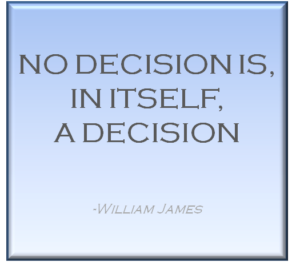I don’t know about you, but the enthusiasm for some of those plans to make changes in my habits is beginning to lose some steam. Eating healthier seemed like a good idea after I came off of my holiday dessert binge. But now the Super Bowl is around the corner and visions of chili and chicken wings are dancing in my head. I can always get on a healthier plan after the weekend – right? What’s it going to hurt to wait to start?
I’ve been thinking about this a lot lately (no, not just because of a diet). One of our biggest challenges in moving solutions forward with clients is their decision not to get started. Many have good intentions in bringing in automated solutions to streamline their operations. But then they delay moving forward and sometimes even end up killing a project for other priorities – and then continue to do things how they’ve always done them.
In many cases Doing Nothing is our biggest competition.
While I’ve been chewing on this, I came across a blog post from Seth Godin entitled “When will you abandon it?” His perspective made me look at this from another angle.
He pointed out the inevitability of change. Your business practices today don’t mirror those that you had 10, 15, 20 years ago (I hope). Your reliance on carrier pigeons and fax machines has probably dropped significantly. And why wouldn’t it – there are far more efficient ways to communicate. His point was that change is an inevitability – and maybe just embrace that rather than fighting it.
When I think of inaction – I usually think about the cost. Because deciding to continue down the path of your existing processes – or Doing Nothing – does come with a cost. It may be an opportunity cost, a hard currency cost, maybe some combination – whatever – there is a cost.
Managing fixed asset inventories is an area where many organizations continue to do things how they always have. They may send out a spreadsheet for verification, send staff out to do counts, maybe invest in extra supplies of key tools like laptops, to make sure they are always available in case you can’t find a spare when you need it.
So what is the cost here? Well, you’ve got a small collection to consider:
- There’s the cost of time of your resources to do a task outside of their key role (What aren’t they doing while they’re doing this?).
- There’s the accuracy of the data that comes back for your reporting. (How long did it take to get back? Did the person really verify the asset or just sign off? Did you get all of the particulars of the asset that you may need for reporting – or does it need to be done again?)
- How much money is being spent on having a supply of spares?
- What about insurance and taxes? How much money is being paid on assets that may not even be in circulation anymore?
If you’re a small organization, with minimal assets and minimal requirements for reporting – a pen and paper method may do the trick. But as your team grows, you’ll outgrow your processes too – and incur a cost if you choose to do nothing to streamline them.
Whether you’re dealing with asset inventories, other processes, or even personal changes – there is a cost to putting off change. It’s up to you to determine if that cost is worth incurring. After all, ditching the chicken wings this weekend may put you in better shape for that inevitable run-in with George Clooney at the airport.
He flies through St. Louis, right?




